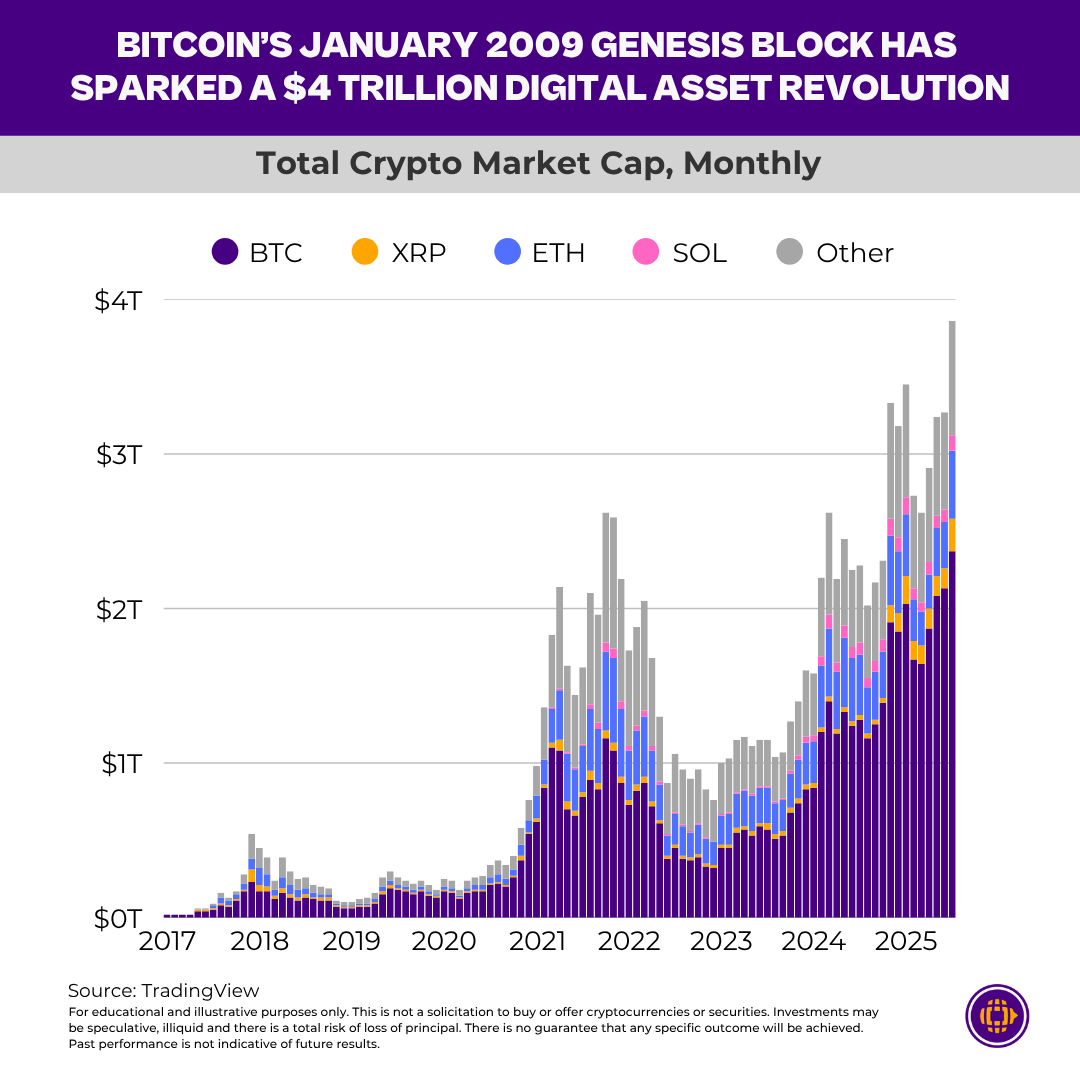Market Cap Milestones: Crypto’s Monthly Climb Since 2017

Bitcoin’s Genesis Block Sparked a $4 Trillion Digital Asset Revolution
Since the debut of Bitcoin’s Genesis Block in January 2009, the crypto market has undergone an extraordinary transformation. What began as a niche experiment in decentralized money has now evolved into a sprawling digital asset ecosystem worth approximately $4 trillion in total market capitalization. The monthly growth trajectory shown above highlights the sector’s meteoric rise over the past eight years, marked by cycles of innovation, speculation, regulatory hurdles, and institutional adoption.

From Bull Runs to Bear Markets – and Back Again
The chart tells a familiar story to crypto veterans: rapid booms followed by sharp corrections. The 2017 ICO mania, which drove the first $800 billion wave of adoption, quickly collapsed in 2018 amid lack of regulatory oversight and failed promises. Yet, that downturn planted the seeds for more robust projects and infrastructures that would later form the foundation of DeFi, stablecoins, and institutional-grade custody.
Fast forward to 2020–2021, and the market surged again — this time fueled by growing institutional interest, DeFi innovations, and the rise of Ethereum as the foundation of Web3. The global pandemic also accelerated demand for hard, non-sovereign assets, positioning Bitcoin as "digital gold" and ushering in a new wave of long-term holders.
ETFs and Regulation: Catalysts for the Next Phase
What sets today’s $4 trillion milestone apart is the confluence of regulatory clarity and product access. In 2024, the approval and launch of spot Bitcoin and Ethereum ETFs opened the doors for both retail and institutional capital to enter crypto markets via traditional brokerage platforms. At the same time, legislative progress — including frameworks like the GENIUS Act and anti-CBDC privacy protection bills — has helped reduce policy uncertainty that long plagued the space.
These twin tailwinds are now enabling a broader reallocation into digital assets, not just from early adopters but from sovereign wealth funds, pension plans, and corporate treasuries. It’s no longer just a tech experiment — it’s a parallel financial system taking shape in real time.
Beyond Bitcoin: The Rise of Multi-Asset Portfolios
While Bitcoin (BTC) still commands the lion’s share of market cap dominance (as shown in deep purple on the chart), the rise of Ethereum (ETH), Solana (SOL), XRP, and a wide array of "Other" tokens reflects an increasingly diverse asset landscape. This fragmentation of value points to a more sophisticated investor class allocating across:
- Smart contract platforms
- Layer 2 scaling solutions
- Stablecoin ecosystems
- Real-world asset tokenization
- Infrastructure protocols
The emergence of differentiated use cases has created the need for more multi-asset crypto portfolios, many of which are now being packaged into regulated investment vehicles.
What’s Next?
The next leg of growth may be driven by factors still taking shape:
- Integration of tokenized assets and securities into traditional markets
- Institutional-grade custody and compliance tooling
- Breakthroughs in scalability and user experience
- The globalization of crypto ETFs beyond the U.S. and Europe
While volatility is likely to remain, the long-term trajectory continues to trend upward. The market’s ability to not only recover from setbacks — but emerge stronger — is a testament to the resilience, innovation, and increasingly institutional foundation of the digital asset space.



